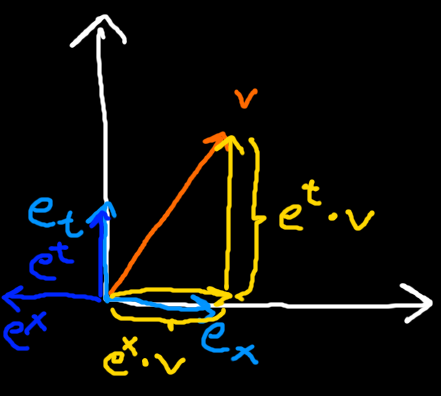Special Relativity with Geometric Algebra - Measuring in Spacetime
In the previous section we derived the Spacetime Algebra used all over GA formualtions of physics. As a next step we need to take a look at how space and time measurements are done in it. For this we will first look at how it is done in ordinary space, and then we will try to figure out how to do it for spacetime.
Measuring in Ordinary Space
We want to measure the size of an object in ordinary space. The thing we want to measure has endpoints
To measure the length of the stick in the X direction, we calculate the inner product with the
Measuring in Spacetime
Does this idea still work in Spacetime? We start by doing exactly the same thing as in ordinary space. We have two events (points in spacetime, having position and time) and we want to measure the difference vector. The difference vector contains both a spatial distance (its
As before, we try doing the inner product with
Did we succeed? Not exactly. The t component is fine, however the x component picked up a minus sign because our spatial basis vectors square to
Reciprocal frames

What we really wanted for measuring the component along one basis vector is a vector whose inner product with it is
In the Spacetime Algebra the spatial basis vectors square to
The collection of reciprocal basis vectors is called a reciprocal frame. We write the reciprocal basis vectors using upstairs letters. For example
Applying this to the first example where we initially failed we get
which is the result we wanted.
General formula for Reciprocal Frames
Another application for reciprocal frames are curvilinear coordinate systems. Here we can have basis vectors which square to neither
Fortunately a very simple formula exists for finding the reciprocal frame for a set of basis vectors in general:
In words, we take the wedge product of all our basis vectors in order except for the one we try to find the reciprocal for and divide by the pseudoscalar. For example applying this to our Spacetime Algebra's
We won't use this formula nor curvilinear coordinate systems in the rest of this series but I thought it is simple and important enough to mention here.
Conclusion
We looked at how measurements are done in ordinary space. Then we saw this way of measuring breaks for our Spacetime Algebra. We found that using reciprocal frames solves this and we wrote down the reciprocal basis vectors for our Spacetime Algebra's basis vectors.
Formulas
- Reciprocal basis vectors:
- Measure
- Spacetime Algebra reciprocal basis vectors:
- Finding reciprocal basis vectors in general:
Up next
Now that we know how to take measurements of vectors, we will look at how observers at different relative speeds measure the same objects.